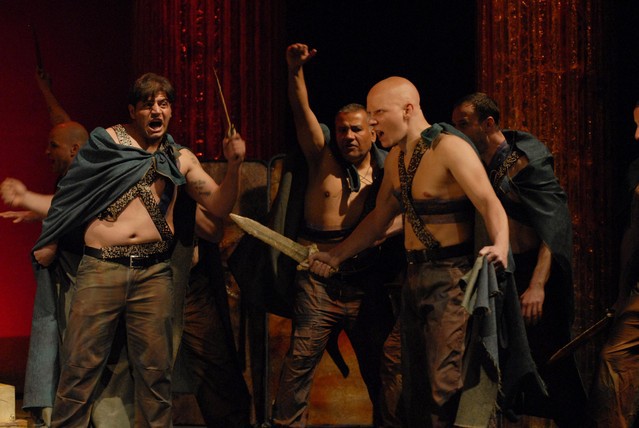I got a big dose of high culture at LSIFF today, with Shakespeare, free jazz, and opera taking up my movies. Read on:
Caesar Must Die is, I must say, the best Shakespeare movie I’ve seen in a while. Part of it is documentary — the movie follows the inmates at Italy’s notorious Rebibbia Prison as they put on their annual stage production, which this year is Julius Caesar. The inmates are hard cases: drug traffickers, murderers, mafiosi. Some of them are also pretty good actors. The director tells them all to perform in their natural accents (Roman, Milanese, Neapolitan, Sicilian, etc.), which made me wish that my ear for Italian was sufficiently developed that I could distinguish the accents. Directors Vittorio and Paolo Taviani film much of it like a straight-up Shakespeare adaptation, cutting together footage of the actors reciting lines alone in their cells and rehearsing in the prison’s hallways and underscoring it with dramatic music. However, we also get things like the audition process and actors relating incidents from their personal lives of crime to the characters that they’re portraying. Salvatore “Sasà” Striano makes an intense Brutus, while gray-haired Cosimo Rega (a 20-year veteran of these productions and a former member of the feared Neapolitan camorra) is an impressively self-contained and manipulative Cassius. The Taviani brothers cut it into a lean and hard-hitting 76-minute movie, one that won the top prize at this year’s Berlinale. It’s a strong winner. Not bad for a couple of filmmakers in their 80s.
I have to start my comments on Ornette: Made in America with an embarrassing confession: I don’t know how to listen to free jazz. I hear that it’s great, and I believe it, but everything from bebop jazz on is still a closed book to me. One day I’ll learn, but for now I had to watch the restored print of this 1985 documentary about the legendary musician and Fort Worth native without understanding what made Ornette Coleman great. No matter; this is still an absorbing work, a free-associative riff that uses some avant-garde documentary techniques that were in use in the 1980s. Instead of talking-heads interviews, the movie cuts together footage of Coleman’s musical performances, rehearsals with his drummer son Denardo, interviews on sidewalks and other locales, and audio of intellectual influences on Coleman such as William Burroughs and Buckminster Fuller. Weirdly, the movie closes with Coleman telling why he got himself circumcised in his 30s. Though it’s sometimes enigmatic, the movie is still invigorating and gorgeously photographed by Ed Lachman (who would go on to serve as cinematographer on movies like The Virgin Suicides and Far From Heaven). The movie features extensive footage from the 1983 world premiere of Coleman’s Skies of America with Fort Worth Symphony Orchestra. I couldn’t help but reflect that FWSO sounds much better now than it did back then. The movie was accompanied by one of Erik Clapp’s short films about the FWSO musicians. FWSO bassist Paul Unger introduced Ornette and said that director Shirley Clarke’s films are hard to find. They must be; this was the first one I’d seen. I want to see more now.
I mentioned earlier that the Taviani brothers are still making good movies in their 80s, but Quartet has a 75-year-old directing his first film. This would be none other than Dustin Hoffman. Odd that he chooses an entirely British-cast film about classical musicians for his debut, but the movie is a fine piece of work. It’s set at an old age home set up especially for retired classical musicians. Maggie Smith portrays a legendary opera singer who goes to live at the nursing home, which seriously upsets her ex-husband and ex-colleague (Tom Courtenay) who already lives there. Hoffman sometimes treats the material more sentimentally than he should, but he generally does a good job with pacing and momentum, and he strikes the right balance between farce and serious drama. There’s also a host of real-life classical musicians portraying the other residents, including the great Welsh mezzo Dame Gwyneth Jones as Smith’s chief professional rival. I wish I had seen A Late Quartet, which is also about classical music and is now playing at the Angelika in Dallas, so I could compare it to this movie. If you want comparisons, though, I prefer Quartet to the similarly themed The Best Exotic Marigold Hotel from earlier this year. It’s a nice first effort by the budding filmmaker; I wonder what he’ll do next.
Todd Berger opened the 2009 LSIFF with his comedy The Scenesters, and now he follows up this year with one called It’s a Disaster. It’s about three couples who gather for a brunch only to find themselves trapped in the house after a terrorist attack releases deadly poison into the air. Berger knows how to write and set up funny gags, and how to get talented actors on his side. (The ones here include David Cross, Julia Stiles, and America Ferrera, plus Berger’s comrades from The Vacationeers.) The trouble is, he has no clue about how to create sympathetic characters. The ones here are petty suburban types who bitch about their personal problems, float paranoid conspiracy theories, and fuss about brunch being ruined while civilization goes to hell. Seriously, if I were trapped in this scenario with these people, I’d hold my breath, run outdoors, and take my chances. Well, if Berger ever figures out how to actually make his characters likable, he’ll be something to be reckoned with.
I went to the horror movie Saturday Morning Massacre on the strength of reading some good reviews. I might have been more impressed if I’d gone in cold. It’s set in the mid-1990s for some reason, and it’s about a team of paranormal investigators who spend a night at a mansion for a rare paying job and are overmatched by what they find. Like LSIFF’s horror flick last year The Innkeepers (which I recently caught up to on DVD), this one emphasizes character, drawing out some tension from the fact that the team makes very little money. It also parodies Scooby-Doo — not only does the team consist of four humans similar to Fred, Daphne, Velma, and Shaggy plus a dog, but there’s also a scene late on when the characters and the monster chase each other through hallways, which is filmed to look like the old Scooby-Doo cartoons. (Why didn’t the two Hollywood movie versions of Scooby-Doo think to do that?) I just wish I had laughed more at the comedy and been scared more by the last 20 minutes or so, when the team realizes that they’ve actually encountered something murderously bad. If only I’d seen this movie before I saw The Cabin in the Woods.
Tomorrow’s the festival’s last day. Let’s see what that turns up.












